With only 7 Saturdays left before the end of the shopping season, the Apex Farmer's Market shopping season I mean, it is time to start asking my favorite protein farmers about bulk purchases before the end of season and off season sales at their farms.Carolina Catch Seafood - Seafood, part of a coastal catcher's cooperative, possible off season sales at a location in Holly SpringsHeston Farms - Beef, family farmers, will do off season sales either at their farm in Roxboro, NC or possibly meeting in Durham so it is still a good idea to stock upLittle River Eco Farm - Pork (they also sell chicken, eggs, beef, turkeys), off season sales are unlikely so I will be placing a bulk order for the Mexican Chorizo and Sweet Italian Sausage that are mainstays in my kitchenOn a related note, the Apex Farmers Market is trying to go year round, possibly one market a month during the off season, but they need an enclosed winter location. Fingers crossed they can find something!
Read MoreMulligan Fire Roasted Cherry Tomato Salsa
A few weeks ago I finally had enough cherry tomatoes to give the Fire Roasted Cherry Tomato Salsa recipe I wrote about in February a whirl. The cherry tomatoes I had in abundance were two varieties of yellow tomatoes and I thought that would work nearly as well as the red. I was mistaken.The salsa was flavorful and had the perfect amount of heat, but without the red tomatoes it lacked the acidic tang this salsa needed to balance the sweetness of the fire roasted onions.So last week I tried again with farmer's market red cherry tomatoes.The kitchen smells unbelievably good during and after the fire roasting step!And the finished product!The mulligan Fire Roasted Cherry Tomato Salsa was delicious and I will need to rethink my yellow/red cherry tomato planting ratio for next year.
Read MoreEating Local Never Tasted So Good - Seafood
I grew up in America's rural heartland calling catfish and crappie 'seafood', but in truth, it would be far more accurate to call it riverfood or lakefood. Real seafood was reserved for restaurant dining and with cautions from in-the-know types to not order on certain days of the week based on restaurant order delivery norms.When I moved to the Raleigh area 3 years ago, one of the bragging points about this region is that we are 2.5 hours from the mountains and 2.5 hours from the coast. But knowing that still did nothing to prepare me for this sign at my local farmer's market:Most Saturdays, Carolina Catch Seafood has a stand at the Apex Farmers Market, selling fresh fish and shellfish, caught the day before and packed on ice, but never frozen. It's like winning the Local Food Lottery!The NC Catch organization has this handy chart of seasonal availability of NC seafood which will be used like the seasonal produce charts to help me meal plan around the season's best. I love shopping the farmer's markets to supplement what I grow and support local, sustainable food producers. Getting to support local fishermen (and women) is a new concept for me, but one that I (sorry, mandatory bad pun) will take to like fish to water!
Read MoreWill Work For Food
The phrases urban agriculture and urban farming answer the where and the what, but not necessarily the why of food production. Some urban growers are producing for personal use (which could include sharing their excess bounty with friends, neighbors and coworkers) while other growers are producing food as part or all of their household income stream.While these two groups take very different approaches to growing, watching Curtis Stone's Profitable Urban Farming workshop intro showed me that the personal grower can learn from some of the strategies and efficiencies of the income grower. We are both working to grow food so a little cross pollination (pardon my pun) of ideas can be beneficial.In this 42 minute video he gives an overview of his commercially successful urban farm in Kelowna, BC. For income growers, there are a lot of interesting ideas presented. He has an innovative strategy for land acquisition that is essentially OPP, other people's property. He rents portions of front, back and side yards from homeowners in his city within a 1 1/4 mile of his home to grow his produce.A very interesting strategy he uses that can be adapted for personal growers is how he categorizes crops as either "quick" or "steady". Quick crops are crops that are ready to harvest in less than 60 days. Steady crops are those "cut and come again" crops that take longer but provide a more sustained harvest. With his 5 growing plots scattered across 1 1/4 mile, he grows his quick crops in the plots closest to him, since they need to be visited more often for planting, rotation and harvest. He plants his steady crops in the furthest plots to since they only need to be harvested once or twice per week.Personal growers can adapt this concept and plant their baby greens and lettuces in the part of their garden closest to the house and plant the squash and onions in the far part of the garden since they need less regular attention.For growers looking to build or expand their business, this video is packed with information. For personal growers, there are some great tips on layout, harvesting and drip irrigation that can be implemented in home gardens.In addition to this workshop intro video, he has a lot of other videos on his YouTube channel worth perusing for both income and personal growers.
To Buy or Not To Buy, That is the Question (Dal Fry)
Each year between September and January the question of "what to grow" must be asked and answered by growers everywhere. This is the time of year when seeds are carefully saved, seed catalogs are perused and garden plans begin to be sketched out for the following year.Asking and answering the question of what to grow necessarily means also answering the question of what not to grow, i.e. "what to buy" the following year with the answer being - everything else.Wendell Berry spoke eloquently on the consumer side of agriculture with his often cited quote, "Eaters must understand that eating takes place inescapably in the world, that it is inescapably an agricultural act, and that how we eat determines, to a considerable extent, how the world is used." So this answer to "what to buy" is in many ways, just as important as what we chose grow.Consumers are considering this question of the provenance of our food more often today and answering it from a variety of perspectives such as the locally-seasonally available movements to reduce food miles like the 100 Mile Diet (and its many variations), the Fair Trade movement and the certified organic movement. We are setting personal standards and restrictions on what we can and will purchase.Though it doesn't have a name or a label, another way to look at growing vs. purchasing locally from other growers vs. purchasing locally after being transported from across the globe is to consider the water content. Fruits and vegetables in particular have incredibly high water content and shipping this water across the world with fossil fuels comes at enormous environmental impact.Foods that are high in water content are highly perishable so the varieties grown are selected for their ability to withstand the journey, not for their flavor or nutrition. The perpetual summer these commercially grown and shipped varieties create in our grocery stores crowds out consumer demand for locally grown produce when it is in season, impacting the number of US family farmers that can make a living growing food.So which foods make a great planned buying list? Outside of locally grown fruits and vegetables, purchased from local farmers when they are in season, buying dried foods which are light and unlikely to be damaged in transport compared to high-water foods helps keep local farmers farming and reduces the need to ship water from one part of the globe to another. Rice, wheat, oats and other grains as well as beans, lentils and pasta are all high in nutrition, lightweight compared to water heavy fruits and vegetables, have a long shelf-life and the water gets added by you when you are ready to use them.A few months ago I wanted to try making a dal fry (a Punjabi lentil dish) and found this great crock pot recipe for toovar dal fry over at The Novice Housewife which I made with only one modification - I added the tomatoes at the end of cooking the dish, not the beginning.The dal fry was fantastic and I wanted to investigate growing lentils myself. I quickly learned that the lentils used in the dish cannot be grown in my humid area so were not a candidate for future garden plans, but since they are a dried and nutritious food as well as being delicious, dal fry will remain on my menu.
Making Hay While The Sun Shines - Part 3
The wonderful thing about being taken under the wing of a traditional southern food mentor is that in addition to the lesson at hand, there are other tantalizing tidbits sprinkled throughout the lessons like breadcrumbs, just waiting for me to pick up the trail.During my green bean pressure canning lesson, the utensil drawer was opened to look for some other object and the Norpro Wood Corn Cutter and Creamer made its debut into my life. My mentor explained that device is used to cream corn, which she does annually with Silver Queen, her favorite hybrid variety. The tool was dropped back into the drawer and the green bean lesson continued.That night I began researching the tool and process of making and preserving creamed corn. My mentor uses the "Another way" method described at the bottom of this link over at the National Center for Home Food Preservation (the online bible for how to safely preserve food). The creamer tool was so inexpensive and the corn so abundant at the NC State Farmers Market, I had to give it a try!My whopping 45.5 lbs of corn had 65 ears in it and sold for only $25 - one of the many great reasons to grow or buy abundantly in season and preserve in wholesome ways for the off season.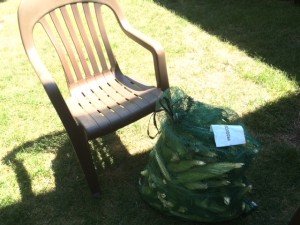 I enlisted help from the cutest and most enthusiastic corn shucker imaginable to get through the pile.
I enlisted help from the cutest and most enthusiastic corn shucker imaginable to get through the pile.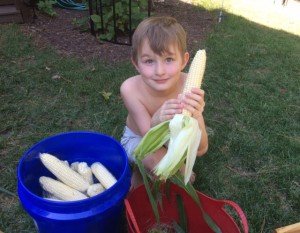 Once shucked, the corn was washed, trimmed of any ear worm damage and ready to be creamed. It took a little experimentation to get the cutters to the right height for the chunkiness I desired. I found compromise by setting it on a creamier height and using knife cut corn once every 8 or so ears to get nice big kernels.
Once shucked, the corn was washed, trimmed of any ear worm damage and ready to be creamed. It took a little experimentation to get the cutters to the right height for the chunkiness I desired. I found compromise by setting it on a creamier height and using knife cut corn once every 8 or so ears to get nice big kernels.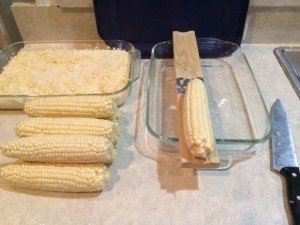 Following the instructions from my mentor and the National Center for Home Food Preservation the creamed corn was cooked in two double boilers for about 10 minutes.
Following the instructions from my mentor and the National Center for Home Food Preservation the creamed corn was cooked in two double boilers for about 10 minutes.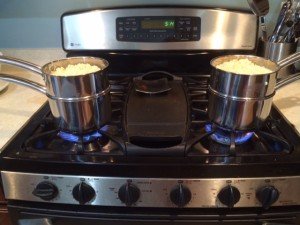 Once thickened it the pots were set in an ice bath to stop the cooking process.
Once thickened it the pots were set in an ice bath to stop the cooking process.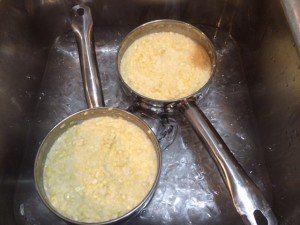 Once cooled, it was ladled into the freezer bags that work with my vacuumsealer at serving sizes of roughly 15.5oz each. They were frozen flat to take up less space then vacuumsealed.
Once cooled, it was ladled into the freezer bags that work with my vacuumsealer at serving sizes of roughly 15.5oz each. They were frozen flat to take up less space then vacuumsealed.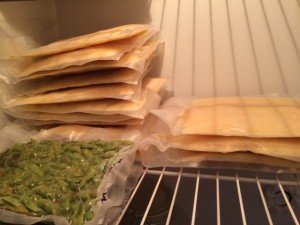 All in all, my 45.5lbs of corn ended up being 15.5lbs of creamed corn with much of the difference being the cobs that were cut up and added to compost so they were a gain for next year's soil also. The entire process took about 4 hours from shucking to the last batch being put in the freezer and finished with a total of 16 servings. I froze 15 of them for the months to come and made one fresh that night. I knew the project was a success (and one likely to be repeated before the end of corn season) when my little shucker took his first bite of our homemade creamed corn and asked if there was enough for seconds.
All in all, my 45.5lbs of corn ended up being 15.5lbs of creamed corn with much of the difference being the cobs that were cut up and added to compost so they were a gain for next year's soil also. The entire process took about 4 hours from shucking to the last batch being put in the freezer and finished with a total of 16 servings. I froze 15 of them for the months to come and made one fresh that night. I knew the project was a success (and one likely to be repeated before the end of corn season) when my little shucker took his first bite of our homemade creamed corn and asked if there was enough for seconds.
Winter Market
Today was the first of two Winter Markets for the Kansas Grown Farmer's Market. The market was held inside the extension building which was a bonus with winds today gusting up to 37mph.I visited with Indian Creek Bison Ranch, a farm that I had seen many times at the entrance to the market but never purchased from before. All the bison are grass-fed, antibiotic and steroid-free so I walked away with a pack of frozen bison burgers to try.I also visited with Morning Harvest Farm that specializes in pastured poultry, pastured eggs and grass-fed beef. Paula was wonderful to talk with and I learned that she shares my passion for Joel Salatin books. Her pastured poultry schooners look to be based on his egg-mobiles. I purchased a package of summer sausage and beef links and grabbed a brochure for her farm.After getting home and getting all the market goodies put away I spent some time with the Morning Harvest Farm brochure and am even more intrigued. They also offer herbs, vegetables and farm raised fish. They have a CSA (Consumer Supported Agriculture) program that runs year round and allows you to select the products you receive. According to the website all CSA shares for Morning Harvest Farms are sold and the waiting list is full. Based on their farm and products I am not surprised. I will be checking back regularly to see when they have an opening on the wait list.
Something Cooking At Nearly Home Grown
I have found myself thinking of the Ant and the Grasshopper over the past 2 months as I have busily worked to build up a full freezer's worth of frozen tomato paste, whole roasting chickens and chicken breasts, butternut squash, spinach and basil hoping that each will manage to retain a bit of the freshness and vitality of summer.Storing the bounty of this year and hoping it will tide me over until the first farmer's market of the spring has inevitably led to thoughts of what next year will bring to the table and freezer. After much thought, planning, reading four Michael Pollan books, one Barbara Kingsolver book and watching more videos from Patti Moreno than I can count, I have decided to start my own garden for 2012 to supplement the organics I purchase from the farmer's markets.I will be experimenting with the Square Foot Gardening method created by Mel Bartholomew with heirloom, open pollinated seeds from Baker Creek Heirloom Seeds and Seed Savers Exchange. I have already learned that there are more different vegetables and varieties of each than our meager yard can contain so I have had to use the cold eye of an executioner to whittle down the roar of 'wants' to a manageable list of 'needs'. Maybe next year will herald some truly home grown goodness here at Nearly Home Grown...In the meantime, I will keep updating with recipes from this year, planning for next year and anything related to local food that sparks an interest!
Winding Down
This weekend I got my first real sense that it was time for the Farmer's Markets to wind down for the year. I visited the Neosho Farms stand to pick up some onions and garlic and asked whether a special they were having on garlic would be available next weekend. The answer was "this is our last weekend for the year".I immediately headed over to Cheney Lake Tomatoes to talk to John about his tomatoes that are sold at Green Acres Market. I asked if there would be any gaps this winter and how often he delivered tomatoes to GAM. I have become attached to my homemade pasta sauce and am having a hard time imagining going back to the jarred stuff this winter. I have looked into canning but am not quite ready to take the plunge just yet.With the end of the season nearing, we will be at the market every Saturday between now and the official end trying to take in a little more of the locally grown, fresh produce and the last of the summer days.
Souped Up
In the middle of what seems like the longest heat wave in history, my 4 year old came down with a head cold. Last weekend I had noticed homemade egg noodles at the Phil's Family Farm booth at the KGFM, so this weekend I stopped by Phil's and picked up 2 8oz bags of the homemade narrow egg noodles.I have a family recipe for chicken noodle soup that calls for boiling a chicken until all that is left is tasteless muscle fiber and using the resulting broth for the soup base. I had also picked up a free range fryer from Phil's, but it seemed like such a waste so I opted to use organic chicken broth instead. I use Pacific Natural Foods low sodium, but any broth you use should be fine.Chicken Noodle Soup8 cups chicken broth3 organic carrots, peeled and thin sliced8 oz. egg noodlesSalt and pepper to taste.Bring broth and carrots to a boil then reduce heat to a simmer. Cook for 20-30 minutes or until carrots are cooked to desired tenderness. Add noodles and cook 7-10 minutes or until noodles are done. Salt and pepper to taste. Makes about 7 servings.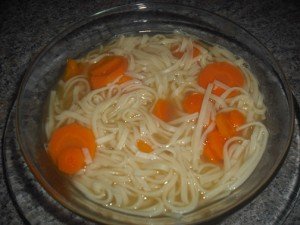
Mangia
I have been fine-tuning a pasta sauce recipe for a few weeks and I think it is as close to 'right' as it is going to get for now. So on Saturday I headed to the Kansas Grown Farmer's Market for fresh tomatoes, garlic and onion. I knew that Saturday was the big annual Tomato Day at the market so hopes were high until ...Cheney Lake Tomatoes had enough for my purposes, so I gathered my other items and headed over to the Old Town Farmer's Market.The Old Town market is more artsy than the Kansas Grown. There are more 'other' stands than fresh produce stands, but they have one that I have been going back to week after week - Pappardelle's by local vendor Pastalicious. I have tried 4 or 5 of their varieties but are currently hooked on the Pasta Luce. The other varieties have been wonderful, but when trying to get the sauce just right I didn't want the distraction of flavored pasta. Pasta Sauce Recipe 2.4.14 tomatoessplash of olive oil (about 2 TBS if you are a precise sort of person)2 cloves of garlic (or to taste)1 medium onion (or to taste)2 teaspoons sugar (I used organic cane sugar)1/2 tsp saltfew sprigs of fresh oregano (1/4 tsp dried or to taste)few sprigs of fresh rosemary (1/4 tsp dried or to taste)few springs of fresh basil (1/4 tsp dried or to taste)bottle of your favorite wineStart by blanching your tomatoes - bring a pot of water large enough to hold them to a boil and prepare an ice bath. While you are waiting for your water to boil, chop your onion (finely), rosemary and oregano. Mince your garlic. Pour a glass of wine and imagine you are cooking in a gourmet kitchen somewhere in Tuscany.Once the water is boiling, put your tomatoes in. If the skins split they are ready for the ice bath. Don't leave them in the boiling water longer than a minute, whether the skins have split or not. Leave in the ice bath for a couple of minutes to completely cool. Check on your wine - it may need to be topped off.Once cooled, core the tomatoes and remove skin. The skin should just peel right off. Chop tomatoes into 1 inch chunks and use either a hand blender or a food processor to blend to desired consistency.Put olive oil in a medium sized sauce pan on medium heat. Add garlic, rosemary, oregano and onion. Cook until the onions are soft and translucent. Add the tomatoes, sugar and salt - bring to a simmer. Simmer for approximately 20-30 minutes, to thicken the sauce. Chop basil and set aside.Get water going for your pasta and start approximately 10 minutes before you want to take your sauce off. When sauce and pasta are both done remove sauce from the heat and stir in basil while you drain pasta. Find your glass of wine and check temperature, bouquet and flavor.Enjoy!
Pasta Sauce Recipe 2.4.14 tomatoessplash of olive oil (about 2 TBS if you are a precise sort of person)2 cloves of garlic (or to taste)1 medium onion (or to taste)2 teaspoons sugar (I used organic cane sugar)1/2 tsp saltfew sprigs of fresh oregano (1/4 tsp dried or to taste)few sprigs of fresh rosemary (1/4 tsp dried or to taste)few springs of fresh basil (1/4 tsp dried or to taste)bottle of your favorite wineStart by blanching your tomatoes - bring a pot of water large enough to hold them to a boil and prepare an ice bath. While you are waiting for your water to boil, chop your onion (finely), rosemary and oregano. Mince your garlic. Pour a glass of wine and imagine you are cooking in a gourmet kitchen somewhere in Tuscany.Once the water is boiling, put your tomatoes in. If the skins split they are ready for the ice bath. Don't leave them in the boiling water longer than a minute, whether the skins have split or not. Leave in the ice bath for a couple of minutes to completely cool. Check on your wine - it may need to be topped off.Once cooled, core the tomatoes and remove skin. The skin should just peel right off. Chop tomatoes into 1 inch chunks and use either a hand blender or a food processor to blend to desired consistency.Put olive oil in a medium sized sauce pan on medium heat. Add garlic, rosemary, oregano and onion. Cook until the onions are soft and translucent. Add the tomatoes, sugar and salt - bring to a simmer. Simmer for approximately 20-30 minutes, to thicken the sauce. Chop basil and set aside.Get water going for your pasta and start approximately 10 minutes before you want to take your sauce off. When sauce and pasta are both done remove sauce from the heat and stir in basil while you drain pasta. Find your glass of wine and check temperature, bouquet and flavor.Enjoy!
Wednesday Market and Hearty Potato-Leek Soup
I visited the Kansas Grown Farmer's Market's Wednesday market for the first time yesterday. It was smaller than I expected with only two stalls, but the two there were well stocked. I had gone looking for Yukon Gold potatoes and onions and left with all I needed.Hearty Potato-Leek Soup3 slices of bacon (more or less depending on your bacon cravings), cut into 1/2 inch squares3 TBS butter3 leeks, thoroughly cleaned and sliced in 1/2 inch chunks1 medium onion chopped7 Yukon Gold potatoes, cleaned and sliced in 1/4 inch slices (I leave the skins on, but this is a personal preference)4 cups chicken broth1 cup heavy creamsalt and pepper to tasteIn a large stock pot on medium heat, cook bacon until well cooked. Add butter and when melted, add onion and leeks. Cook until onions are transluscent. Add potato slices and enough chicken broth to cover (about 4 cups). Cook until potatoes are tender. Use a spoon or potato masher to mash up potatoes to desired size and soup consistency. Add 1 cup heavy cream and cook for another 10 minutes. Remove from heat and enjoy!Makes 4-6 servings
Apple Butter and Tomato Jelly
Today I stopped by the Wild Family Farm stand to pick up a couple of pints of their homemade apple butter. My grandmother made apple butter like this and the taste whisks me back to the table in her small farm kitchen where I would watch her canning while I munched on a slice of bread slathered in her apple butter.The WFF stand has a good assortment of fresh herbs, decorative plants, jams and jellies. While I was there, I perused some of the other labels and saw one for Tomato Jelly. Apparently tomato jelly has a small, but devoted fan club that seek out this unusual delicacy wherever it can be found. I have never had it and my brain can't quite reconcile the idea of tomatoes and a jelly into a single item. But I was told it does have it's fans, so if you are near Wichita, KS and need a tomato jelly fix, now you know where to find it.
The Genesis Story
Two weeks ago I went to the Kansas Grown Farmers’ Market and came away with 7 organically grown Geronimo tomatoes (Cheney Lake Tomatoes) and 2 organically grown Genovese Compact, Improved Basil plants (Wild Family Farm).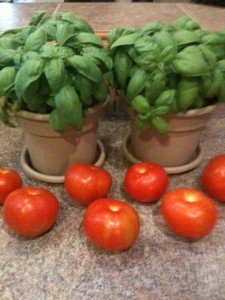 Saturday I went back for a dozen more tomatoes and a third basil plant. It’s official. I'm hooked.
Saturday I went back for a dozen more tomatoes and a third basil plant. It’s official. I'm hooked.

